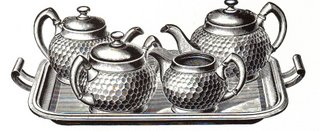
Today, May 9th …
Today we are going to clarify some of the misunderstandings about the meaning and conduct of “High Tea”.
If you want to play high-and-mighty, and crook your little finger just so, what you really want is “Low Tea”. The Daily Telegraph on this day in 1893 explained:
A well-understood `high tea' should have cold roast beef at the top of the table, a cold Yorkshire pie at the bottom, a mighty ham in the middle. The side dishes will comprise soused mackerel, pickled salmon (in due season), sausages and potatoes, etc., etc. Rivers of tea, coffee, and ale, with dry and buttered toast, sally-lunns, scones, muffins, and crumpets, jams and marmalade.
In other words, high tea is a substitute for dinner, taken in the evening at a high table, and is definitely low class in its origins. Low tea, on the other hand, is taken in the afternoon at low tables and is indisputably a high class affair (only the upper classes being able to sit about in the mid-afternoon.)
So, if you want your high tea to be well understood, you must master the art of grand pie making. Unfortunately the recipe for the Yorkshire pie may be intimidating for all but the bravest, so is hidden away in safety on the Companion site.
If you are not sure whether it is low tea or high tea you want to serve, “Sally Lunns” will be acceptable at either. These are sweet buns with much interesting fake-lore attached to their name, and really require a whole 400 words to themselves just as soon as possible.
There are three versions of the recipe in Cassell’s “Dictionary of Cookery” (c1870’s). The most elegant is supposedly Carême’s own, but space only permits this short one.
Sallylunns (another way)
Take two pounds of flour, one pint of milk, four eggs, and two spoonfuls of yeast; make a paste of these ingredients, and work until well risen. Then knead into it a pound of butter and a little salt; let it stand an hour, then bake, and rasp the tops. A little pounded sugar may be added to taste to the above ingredients.
Cassell’s “Household Guide” advises:
When wanted, slice, toast, and butter your Sally Lunns, and serve piping hot on a plate which you cannot hold with your naked fingers.
And cautions:
There are two objections to these and the following [muffins] - they are indigestible, and are also terrible "stroys" [destroyers] for butter.
Tomorrow: The legality of tomatoes.
On this Topic ...
Usually nowadays when we think of Afternoon Tea, we think of something like Devonshire Tea, with scones and cream. Scones are certainly popular afternoon fare in Australia. You can read about the Great Aussie Scone Fest on Miss Eagle's site at Oz Tucker, or if you didn't check it out after the post on "Colonial Kosher", check out Gillian Polack's diary Even in a Little Thing for May 4th - she has given some of the scone recipes from the cookbook of her Jewish grandmother who migrated to Australia in the 1850's.
Quotation for the Day …
In nothing more is the English genius for domesticity more notably declared than in the institution of this festival - almost one may call it - of afternoon tea. The mere chink of cups and saucers tunes the mind to happy repose. George Gissing (1857- 1903)
No comments:
Post a Comment